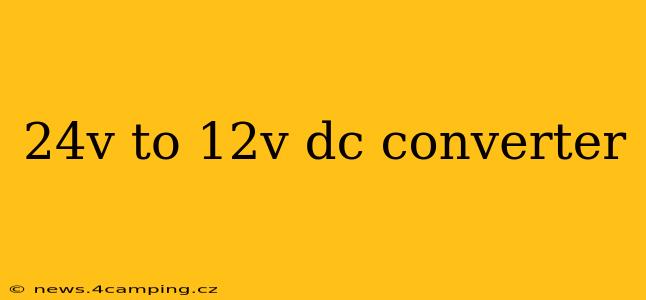Converting 24V DC to 12V DC is a common requirement in various applications, from automotive systems and industrial equipment to powering smaller devices from a higher-voltage source. This guide will explore the different types of 24V to 12V DC converters, their applications, and factors to consider when choosing the right one for your needs.
What is a 24V to 12V DC Converter?
A 24V to 12V DC converter, also known as a step-down converter or buck converter, is a device that reduces a 24-volt DC input voltage to a 12-volt DC output voltage. This is achieved through various electronic circuits that regulate the voltage efficiently. The key function is to safely and reliably lower the voltage while maintaining a stable 12V output, even if the 24V input fluctuates.
Types of 24V to 12V DC Converters
Several types of converters exist, each with its own strengths and weaknesses:
-
Linear Regulators: These are simple and inexpensive but less efficient, especially at higher currents. They dissipate excess power as heat, leading to lower efficiency and potential overheating.
-
Switching Regulators (Buck Converters): These are significantly more efficient than linear regulators, especially at higher currents, as they switch the current on and off rapidly to regulate the voltage. This results in less heat generation and better overall performance. Most modern 24V to 12V converters use this technology.
-
Isolated Converters: These offer galvanic isolation between the input and output, providing increased safety and protection against electrical surges. This is crucial in applications where safety is paramount.
How to Choose the Right 24V to 12V DC Converter
Selecting the appropriate converter depends on several factors:
-
Output Current: This is the most crucial parameter. Choose a converter with an output current rating that exceeds the maximum current demand of your 12V devices. Underestimating this can lead to damage or malfunction.
-
Efficiency: Switching regulators are generally more efficient (often above 80%) than linear regulators. Higher efficiency translates to less wasted energy and heat generation.
-
Input Voltage Range: Consider the potential variations in your 24V input voltage. The converter should be able to handle these fluctuations without compromising performance or safety.
-
Regulation: Look for converters with tight voltage regulation to ensure a stable 12V output, even under varying loads or input voltage.
-
Protection Features: Overcurrent, overvoltage, and short-circuit protection are essential safety features to prevent damage to the converter and connected devices.
What are the different applications of a 24V to 12V DC converter?
24V to 12V DC converters find use in a wide array of applications, including:
-
Automotive Systems: Powering 12V accessories in vehicles with 24V electrical systems (e.g., trucks, buses).
-
Industrial Control Systems: Supplying power to 12V sensors, actuators, and other components in industrial automation equipment.
-
Telecommunications: Providing power for 12V equipment in telecom installations.
-
Renewable Energy Systems: Converting higher voltage outputs from solar panels or wind turbines to 12V for smaller loads.
What are the advantages of using a 24V to 12V DC converter?
The primary advantages are:
-
Voltage Reduction: Safely steps down a higher voltage to a lower voltage suitable for various devices.
-
Power Supply Flexibility: Allows 12V devices to be powered from a 24V source, increasing flexibility in system design.
-
Improved Efficiency (with Switching Regulators): Minimizes energy loss and heat generation.
-
Safety Features: Many converters incorporate protection circuits to enhance safety.
What are the disadvantages of using a 24V to 12V DC converter?
While offering many benefits, converters can have some drawbacks:
-
Cost: High-quality converters with advanced features can be relatively expensive.
-
Size and Weight: Depending on the power rating, converters can add to the overall size and weight of a system.
-
Efficiency Losses (with Linear Regulators): Linear regulators can have significant efficiency losses, especially at higher currents.
-
Heat Generation (with Linear Regulators): Heat generation in linear regulators requires adequate heat sinking.
By carefully considering the factors discussed above, you can select the ideal 24V to 12V DC converter to meet the specific requirements of your application, ensuring efficient, reliable, and safe operation.
